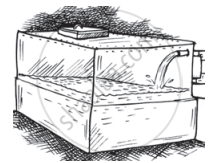Advertisements
Advertisements
Question
If V is the volume of a cuboid of dimensions a, b, c and S is its surface area, then prove that \[\frac{1}{V} = \frac{2}{S}\left( \frac{1}{a} + \frac{1}{b} + \frac{1}{c} \right)\]
Solution
\[\text { It is given that V is the volume of a cuboid of length = a, breadth = b and height = c . Also, S is surface area of cuboid . } \]
\[\text { Then, V = a } \times b \times c\]
\[\text { Surface area of the cuboid } = 2 \times \text { (length } \times \text { breadth + breadth }\times \text { height + length } \times \text { height) }\]
\[ \Rightarrow S = 2 \times (a \times b + b \times c + a \times c)\]
\[\text { Let us take the right - hand side of the equation to be proven } . \]
\[\frac{2}{S}(\frac{1}{a}+\frac{1}{b}+\frac{1}{c}) = \frac{2}{2 \times (a \times b + b \times c + a \times c)} \times (\frac{1}{a}+\frac{1}{b}+\frac{1}{c})\]
\[=\frac{1}{(a \times b + b \times c + a \times c)} \times (\frac{1}{a}+\frac{1}{b}+\frac{1}{c})\]
\[\text { Now, multiplying the numerator and the denominator with a } \times b \times c, \text { we get: } \]
\[\frac{1}{(a \times b + b \times c + a \times c)} \times (\frac{1}{a}+\frac{1}{b}+\frac{1}{c}) \times \frac{a \times b \times c}{a \times b \times c}\]
\[=\frac{1}{(a \times b + b \times c + a \times c)} \times (\frac{a \times b \times c}{a}+\frac{a \times b \times c}{b}+\frac{a \times b \times c}{c}) \times \frac{1}{a \times b \times c}\]
\[=\frac{1}{(a \times b + b \times c + a \times c)} \times (b\times c+a\times c+a\times b) \times \frac{1}{a \times b \times c}\]
\[=\frac{1}{(a \times b + b \times c + a \times c)}\times(a\times b+b\times c+a\times c) \times \frac{1}{a \times b \times c}\]
\[=\frac{1}{a \times b \times c}\]
\[=\frac{1}{V}\]
\[ \therefore \frac{2}{S}(\frac{1}{a}+\frac{1}{b}+\frac{1}{c}) = \frac{1}{V}\]
APPEARS IN
RELATED QUESTIONS
Find the height of a cuboid whose base area is 180 cm2 and volume is 900 cm3?
Water is pouring into a cubiodal reservoir at the rate of 60 litres per minute. If the volume of the reservoir is 108 m3, find the number of hours it will take to fill the reservoir.

A wooden bookshelf has external dimensions as follows: Height = 110 cm, Depth = 25 cm, Breadth = 85 cm in following figure. The thickness of the plank is 5 cm everywhere. The external faces are to be polished and the inner faces are to be painted. If the rate of polishing is 20 paise per cm2 and the rate of painting is 10 paise per cm2. Find the total expenses required for polishing and painting the surface of the bookshelf.

The length of the longest rod that can be fitted in a cubical vessel of edge 10 cm long, is
Total surface area of a box of cuboid shape is 500 sq. unit. Its breadth and height is 6 unit and 5 unit respectively. What is the length of that box ?
Find the length of each edge of a cube, if its volume is :
(i) 216 cm3
(ii) 1.728 m3
The length breadth and height of a cuboid are in the ratio of 3 : 3 : 4. Find its volume in m3 if its diagonal is `5sqrt(34)"cm"`.
A room is 22m long, 15m broad and 6m high. Find the area of its four walls and the cost of painting including doors and windows at the rate of Rs.12per m2.
A metallic sheet is of the rectangular shape with dimensions 48cm x 36cm. From each one of its corners, a square of 8cm is cutoff. An open box is made of the remaining sheet. Find the volume of the box.
A cuboidal tin box opened at the top has dimensions 20 cm × 16 cm × 14 cm. What is the total area of metal sheet required to make 10 such boxes?
